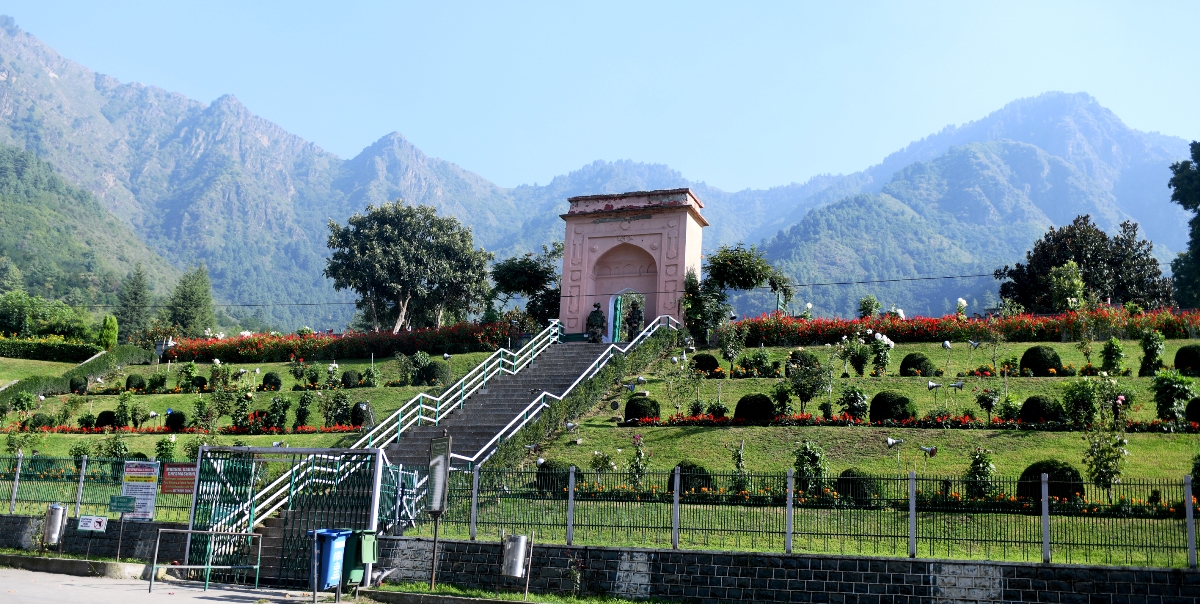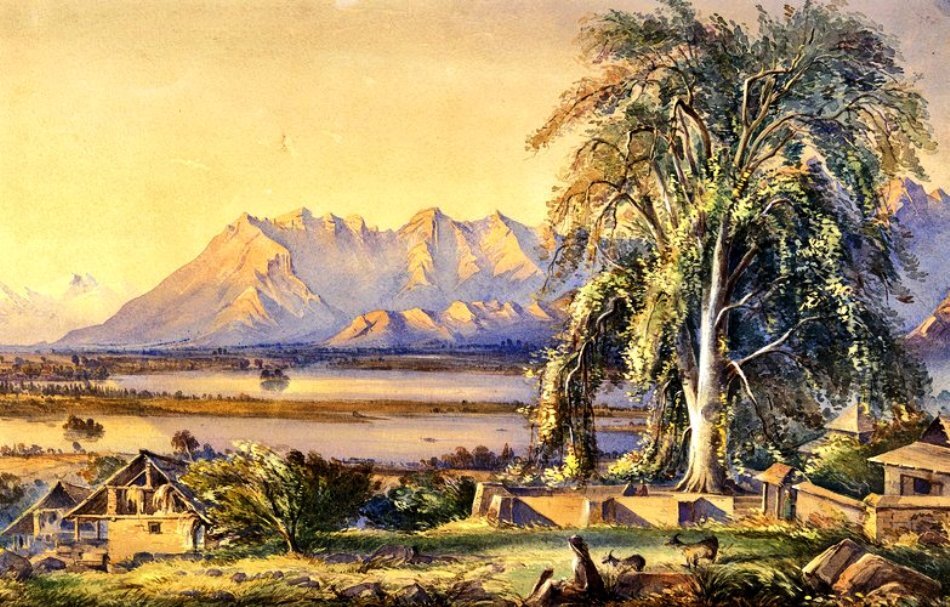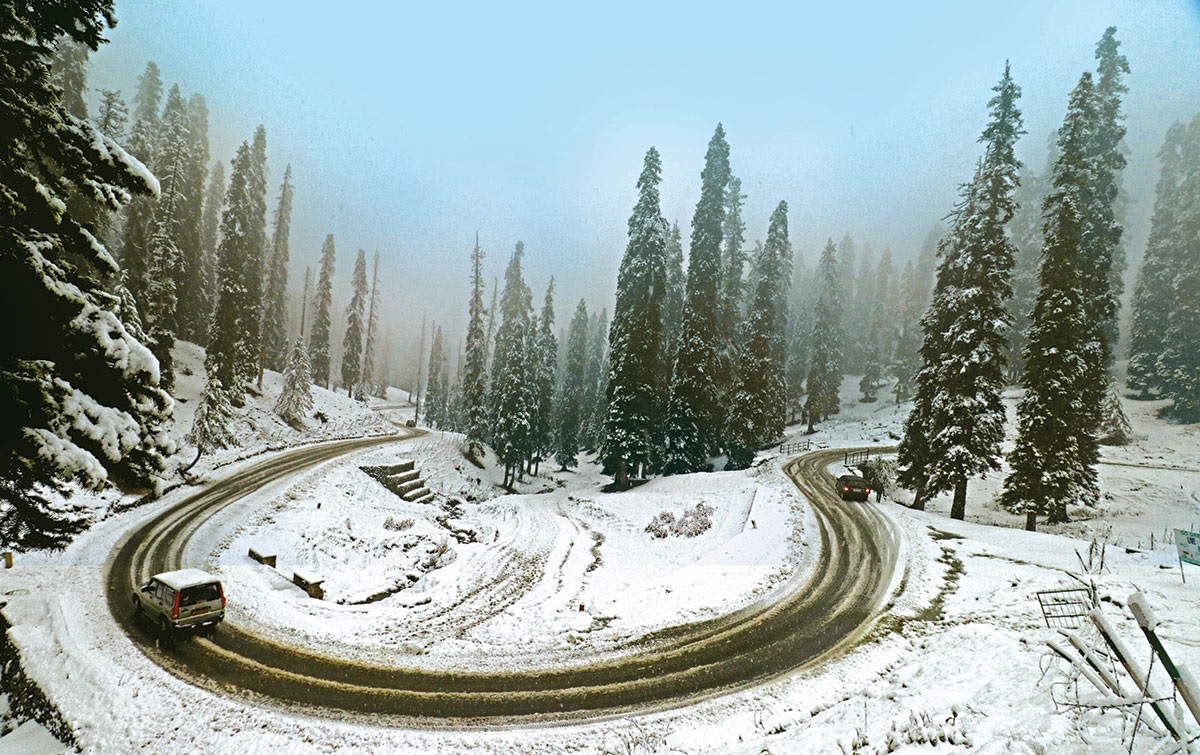by Umaima Reshi
Chashma Shahi adheres to classic Mughal Garden design principles, characterised by geometric shapes, axial symmetry, and incorporation of water features.

Chashma Shahi, (The Royal Spring), stands as an embodiment of Mughal opulence and architectural prowess. It was commissioned and designed in 1632 AD by Ali Mardan Khan, a governor appointed by Mughal Emperor Shah Jahan, as a gift for the ruler’s eldest son, Prince Dara Shikoh. Situated within the Zabarwan Range near Raj Bhawan Srinagar, with a commanding view of Dal Lake in Srinagar, Kashmir, Chashma Shahi holds a significant position among the Mughal gardens.
Adjacent to Chashma Shahi is the Pari Mahal where Dara Shikoh pursued the study of astrology. Despite being the smallest among Srinagar’s three Mughal gardens – Shalimar being the largest and Nishat the second largest – Chashma Shahi spans an acre, measuring 108 meters in length and 38 meters in width. All three gardens grace the right bank of Dal Lake against the backdrop of the Zabarwan Mountain.
The name Chashma Shahi, is aptly descriptive. True to its name, the garden features a natural spring believed to possess healing properties. The spring’s water, thought to hold medicinal efficacy, was even transported to Delhi by India’s First Prime Minister, Pandit Jawaharlal Nehru.
History
Ali Mardan Khan, renowned for his contributions to art and architecture, commissioned the garden in 1632 AD. His architectural legacy extends beyond Kashmir, including projects in Lahore, Pakistan, such as the Aliabad Sarai and Baghe Ali Mardan Khan. According to architectural historian Sameer Hamdani, wealthy individuals in the eighteenth or nineteenth century sourced water from the spring through a system of bhishtis (watermen) when water services were scarce.
Chashma Shahi stands as a distinguished jewel among Kashmir’s Mughal gardens, providing a serene retreat for visitors. Encompassing a sizable area, the garden embodies Mughal design principles, seamlessly blending detailed landscaping with natural elements to create a harmonious and regal environment.
Architecture and Design
Chashma Shahi adheres to classic Mughal Garden design principles, characterised by geometric shapes, axial symmetry, and incorporation of water features. The garden comprises three terraces, each with distinct features, offering visitors panoramic views of the surrounding mountains and Dal Lake as they ascend.
The architectural influences on Chashma Shahi reflect Mughal aesthetics, particularly those derived from Persian gardens. The central theme revolves around a natural spring flowing through the terraces. The spring, divided into three segments – an aqueduct, waterfall, and fountains – descends through the terraces, culminating in a square five-fountain pool at the lowest level. Stairwells on both sides guide visitors to the spring.
The focal point is the uppermost terrace housing the royal spring, encased in a black stone pavilion adorned with intricate Mughal architecture, showcasing detailed carvings and exquisite craftsmanship. The first terrace, serving as the garden’s entrance, features cascading fountains and a two-story Kashmiri hut highlighting the authentic spring. Flowing through fountains, conduits, and steep terraces, the water creates a captivating network that enhances the garden’s aesthetics.
Recent additions, including two barahdaris, the bounding area, and a side entry, are modern structures, while cascades, plinths of the barahdaris, water chutes, tanks, and fountains remain authentic Mughal constructions undergoing renovation.
Moving to the second terrace, a tank with a fountain and a shaped chute directs water from the upper terraces. Supplied by the royal spring, this perennial source fills a lotus basin at the centre of the terrace. Meticulously groomed flowerbeds, vibrant blossoms, and well-crafted pathways adorn the terrace.
The lowest terrace features a centrally positioned tank with five fountains arranged in a quincunx pattern. Stairwells on either side lead to the second terrace and the ground level of the barahdari. An inscription at the gateway adds a poetic touch to Chashma Shahi’s historical significance, connecting visitors to this Mughal garden’s timeless beauty and regal legacy.
Present Eminence
Beyond its architectural and artistic significance, Chashma Shahi holds cultural and historical importance, standing as a testament to the enduring legacy of the Mughals in Kashmir. The garden has weathered centuries of political and social change, contributing to the region’s cultural heritage.
Chashma Shahi is particularly popular among tourists during spring and early summer, offering a picturesque view of Dal Lake, considered captivating by visitors. In spring, the landscape transforms with fields of blossoming Rapeseed (canola) adorning lush hill slopes in gold. Snow-capped mountains receive annual melting snow and frequent showers, with white clouds drifting across the sapphire sky, casting shadows on the sharp mountain peaks. Extensive areas of Chashma Shahi Hill and Hari Parbat slopes are enriched with red and white almond blossoms, creating a captivating spectacle for observers from the arch of the barahdari. The gentle murmur of the central fountain enhances the overall impression.
As visitors explore the terraces, appreciate the architecture, and experience the soothing impact of the royal spring, they become part of Chashma Shahi’s rich history and heritage.
In contemporary times, Chashma Shahi continues to attract tourists, historians, and environmental enthusiasts. The garden serves as a tranquil retreat from daily life, allowing visitors to connect with nature and appreciate the timeless elegance of Mughal garden design. Well-maintained structures, lush greenery, and the therapeutic sound of the royal spring make Chashma Shahi an essential travel destination for those seeking a peaceful getaway in the heart of Kashmir.
Chashma Shahi, with its historical significance, architectural excellence, and scenic beauty, remains a cherished destination for those exploring the Mughal legacy amidst the pristine charm of Kashmir.

Accessibility Information
Chashma Shahi is located approximately five and a half miles from Srinagar, situated off the road leading to Nishat. While the garden’s initial size may not have been expansive, historical evidence suggests it was once more extensive than its current boundaries.
Conveniently positioned within Srinagar city limits, Chashma Shahi is approximately 14 kilometres northeast of Srinagar Airport. Numerous nearby hotels and restaurants cater to tourists, enhancing its appeal as a convenient destination.
Chashme Shahi is a prominent tourist attraction in Srinagar, open to the public only during the optimal period from March to November. The months of May and June are particularly enchanting when the flowers are in full bloom. The garden welcomes visitors from 9:30 am to 5:30 pm, and an entry fee of Rs 10 for adults and Rs 5 for children is applicable.















